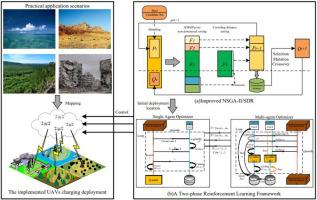Joint reinforcement learning to optimize multiple UAV charger deployments for individual energy requirement in IoT
IF 9.6
Q1 COMPUTER SCIENCE, ARTIFICIAL INTELLIGENCE
引用次数: 0
Abstract
The technology of wireless power transfer (WPT) utilizing unmanned aerial vehicles (UAVs) presents novel avenues for enhancing the longevity of wireless sensor networks (WSNs), which constitute a critical component of the Internet of Things (IoT). However, existing research on charging deployment generally overlooks the heterogeneous energy requirements within the network, resulting in low charging efficiency for high-energy-consuming nodes. This paper addresses the multiple UAVs optimal cooperative charging deployment problem (MUAVs-OCCDP) and proposes a phased optimization strategy. Firstly, it constructs the network topology and records the energy requirements of the nodes. Based on the strength advantage relationship (SDR), an improved NSGA-II algorithm is designed to generate the initial deployment plan. Then, a two-phase reinforcement learning framework is established: the phase 1 aims to reduce the number of UAVs by optimizing the number of covered nodes and the average charging efficiency; the phase 2 promotes collaboration through the sharing of multi-agent experience and a hybrid reward mechanism to achieve balanced charging energy distribution.

联合强化学习优化多个无人机充电器部署,以满足物联网中单个能源需求
利用无人机(uav)的无线电力传输(WPT)技术为提高无线传感器网络(wsn)的使用寿命提供了新的途径,无线传感器网络是物联网(IoT)的关键组成部分。然而,现有的充电部署研究往往忽略了网络内部的异构能量需求,导致高能耗节点的充电效率较低。针对多无人机最优协同充电部署问题(muav - occdp),提出了一种阶段性优化策略。首先,构建网络拓扑,记录节点能量需求;基于力量优势关系(SDR),设计了一种改进的NSGA-II算法生成初始部署方案。然后,建立了两阶段强化学习框架:第一阶段通过优化覆盖节点数和平均充电效率来减少无人机数量;第二阶段通过多智能体经验共享和混合奖励机制促进协作,实现充电能量均衡分配。
本文章由计算机程序翻译,如有差异,请以英文原文为准。
求助全文
约1分钟内获得全文
求助全文
来源期刊

Energy and AI
Engineering-Engineering (miscellaneous)
CiteScore
16.50
自引率
0.00%
发文量
64
审稿时长
56 days
 求助内容:
求助内容: 应助结果提醒方式:
应助结果提醒方式:


